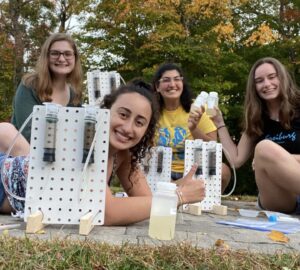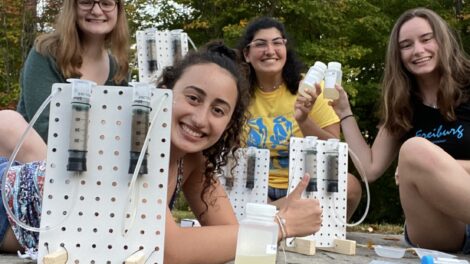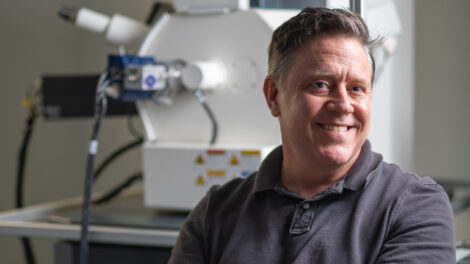Building on stronger grounds
By Bryan Hay
An interdisciplinary group at Lafayette College is growing bacteria as part of an innovative research project aimed at strengthening soil.
Faculty and students have been growing bacteria in sand and natural soils in 3-inch-tall plastic columns. The bacteria like to “eat” urea, a widely used nitrogen fertilizer, and in the process they create a high pH environment in the soil.
“We then use that high pH environment to our advantage,” says Mary Roth, Simon Cameron Long Professor of Civil and Environmental Engineering. “We add calcium in solution, and because it is a high pH environment, the calcium precipitates out of the solution and becomes a solid that binds the soil particles together. Basically, we take loose soil and create small bricks.”

Engineering and microbiology students with their soil samples in 2020
The current goal is to develop a simple and economical method to test different soil types to see if the process works in them.
“Once we’ve developed the method, we hope to have students at schools from across the nation and the globe test the soils in their areas and share that data with researchers and practicing engineers, so that the research and engineering community can learn more about where the process works best and why it works in those areas,” Roth says.
Knowledge of the process is approaching the point where it might be economically feasible to bring it into the field, possibly to strengthen loose soils under a building. With stronger soil under the building, it might be able to tolerate increased loads or might be better able to survive in an earthquake.
Working with Laurie Caslake, Kreider Professor of Biology, Roth says they hope to conduct a large pilot project involving students and faculty at other institutions. The project is being done in collaboration with the National Science Foundation’s Engineering Research Center for Bio-mediated and Bio-inspired Geotechnics.
“The research aims to improve our knowledge of the use of microbial-induced calcite precipitation as a method to increase the strength of soils using bacteria that are currently in the soil,” Roth says. “It is an environmentally friendly solution to real-world geotechnical problems.”

